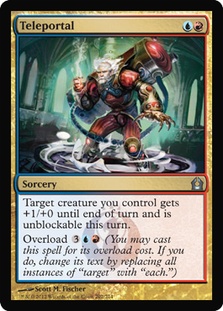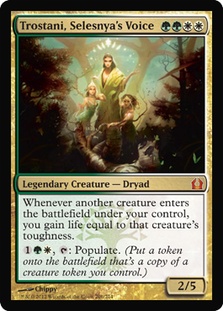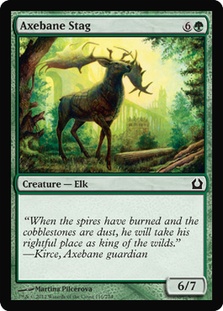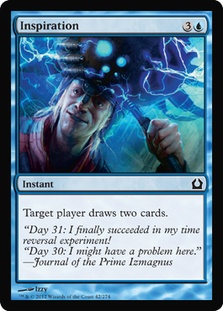I’d like to be able to talk to you all about Standard this week. I really would. The format looks awesome, with a whole bunch of decks chock full of sweet cards posting solid results and new ones popping up every week. By far the most common question I’ve been hearing these days whether on Facebook, Twitter, or in person at events is: “What do you like in Standard right now?” But there’s a problem. I haven’t played a single game of the new Standard format!
I know, I knowâ€â⒬�I’m slacking. But I’m a busy guy! Right when the set came out, my focus was on Modern for the Pro Tour. After that, it was Draft for GP Philadelphia this past weekend. Add that to my day job working to bring you SolForge and future Ascension expansionsâ€â⒬�not to mention getting stranded in Philly for days without a laptop to play Magic Online thanks to the hurricaneâ€â⒬�and I’ve been hard pressed to find time to play Standard. But worry notâ€â⒬�with back to back Standard Grand Prix coming up in Charleston and San Antonio, I’m going to be making up for lost time over the next few weeks, so I’ll be sure to keep you all posted with what I find.
In the meantime, I want to share some insights from my recent experiences playing Return to Ravnica Limited. No, this isn’t going to be a tirade about Pack Rat, though I do agree that it’s one of the worst designed cards for Limited in recent memory (although I think the bigger problem is repetitive and boring game play rather than power level). Instead, I’m going to talk about some key concepts to think about when you’re playing RTR Limited, including both Sealed Deck and Draft.
Ã’Â
Understand the Archetypes
Return to Ravnica Limited has a handful of major archetypes largely defined by the guild mechanics. It’s important to understand what each of them looks like in order to build decks that match up well against them. In some of the first drafts I did, I ended up with aggressive decks that looked awesomeâ€â⒬�a bunch of fast creatures paired up with removalâ€â⒬�and maybe they would have been in a different format. But my 2/1 creatures matched up poorly against the 2/3, 3/3, and 2/4 creatures my opponents played, and I couldn’t afford to spend my removal on every creature that got in the way.
These are what I consider the major archetypes of RTR Limited, their defining characteristics, and key common cards.
Selesnya Populate: Generally considered the strongest archetype, this deck combines efficient creatures with the ability to play for the mid/long game with token generation and populate effects. Games frequently involve generating quite a few Centaurs, so beating this deck takes being able to effectively attack into or block 3/3 creatures. Key cards include Centaur’s Herald, Centaur Healer, Eyes in the Skies, Rootborn Defenses, and Courser’s Accord.
Selesnya Aggro: Plays aggressively with efficient creatures and pump spells. Key cards include Centaur Healer, Sunspire Griffin, Common Bond, and Giant Growth.
Azorious Fliers: Classic U/W aggro plus detain. Races in the air while defending on the ground. Key cards include Sunspire Griffin, Hussar Patrol, Dramatic Rescue, and Voidwielder.
Rakdos Aggro: Aggro deck using quality unleash creatures. Key cards include Splatter Thug, Dead Reveler, Gore-House Chainwalker, Auger Spree, Traitorous Instincts, and Deviant Glee.
Izzet Aggro: Aggro deck with spell backup. Key cards include Frostburn Weird, Splatter Thug, Pursuit of Flight, Goblin Electromancer, Gore-House Chainwalker, Lobber Crew, and Traitorous Instincts.
Golgari Midrange: Can play aggressively or a value game with scavenge creatures, including assembling Voltron by scavenging up a lifelinker. Key cards include Drudge Beetle, Sluiceway Scorpion, Daggerdrome Imp, Stonefare Crocodile, and Grim Salvage.
Looking over this list, it becomes clear that creatures like Rakdos Shred-Freak and Azorious Arrester just aren’t going to cut it as attackers. This is a format of 3/3s and X/4s, so 2/1s just don’t have what it takes to compete. That four Shred-Freak deck may have been awesome in Zendikar, but there was only one Giant Scorpion in that set. This set has tons of them, so prepare accordingly.
Prepare for Stalemates
As the above archetype list suggests, there are a lot of creatures with big butts in RTR Limited. Hussar Patrol, Towering Indrik, Lobber Crew, Voidwielder, Trestle Troll, Concordia Pegasus, etc. On top of that, even creatures with typical power and toughness ratios can find themselves breeding like rabbits to clog up the board. It’s important to either have a plan to win the game before things get clogged up or have some way to break through a stalemated board. This is particularly important in Sealed Deck, where most decks tend to feature removal and bombs.
This tendency for the board to stalemate is one of the reasons Stab Wound is the best common in the set. Stab Wound is at its best when it’s not actually killing a creature but neutralizing it so it’s no longer a threat and constantly dealing damage to the opponent. It’s not uncommon for Stab Wound to deal upwards of ten damage over the course of a game, and sometimes it’s all you need to go the distance. Playing for Top 8 of the Grand Prix, Martin Juza defeated his opponent with nothing but eighteen points from Stab Wound and two from a Launch Party.
Ã’Â
Ã’Â
The presence of such a devastating common in stalemate situations is one of the reasons it’s so important to have a plan to break out of them. Cards like Blustersquall and Teleportal are excellent in any kind of aggressive or even semi-aggressive deck. I frequently find myself splashing Teleportal in Azorious and Rakdos decks, as you can see in my draft video this week. It’s exactly the sort of card that I like to splash: a late game card that’s sufficiently high impact that it’s worth spending some time with it stranded in your hand if you can’t cast it. Teleportal frequently just ends the game on the spot, so that’s high enough impact for me.
Another stalemate breaker that’s gone up dramatically in my estimation is Rogue’s Passage. I particularly like the Passage in Golgari decks where I have some kind of enormous monster to send through. As an added bonus, it can be fetched with Grisly Salvage. I’ll play the Passage in virtually any deck that can afford the colorless land and will even fit it in as an eighteenth land in decks that are stretching for mana requirements. For extra value, be sure to comment how silly it is that your Risen Sanctuary can even fit inside a passage designed for rogues. I mean, come onâ€â⒬�that thing is HUGE!
Maximize Your Sideboarding
Much has been said about the importance of sideboarding in Magic, though most of it has been about Constructed. Sideboarding in Limited isn’t quite as straightforward but can be equally valuable. Some of it is obviousâ€â⒬�it doesn’t take a Hall of Fame ring to realize you’ll want to bring in Sundering Growth against an opponent with Collective Blessing, for instance. But some of it is a bit more subtle, and it’s worth looking into it. ÂҠÂÒÂ
At GP Philly, a lot of people spent time during their byes getting input from other players about the way they built their sealed decks. Return to Ravnica sealed decks are particularly challenging to build, leading many players to realize they made a mistake the first time and decide to sideboard into a different configuration after game 1s. I had a challenging build myself, with some quality G/W cards like Loxodon Smiter and Trostani but not quite enough token-making support to make it work and no real ability to break through stalemates. Ultimately, I put together an Izzet splash white deck with a lot of tricks that matched up well against any opponent who was trying to play a longer game, which makes up a lot of sealed decks.
The problem was against aggressive decks, where my Izzet build faltered. I didn’t have any Frostburn Weirds and only a single Lobber Crew, so I was hard pressed to fend off an assault from Splatter Thugs, Dead Revelers, and friends. My solution? Sideboard into a completely different deck after game 1 against Rakdos opponents. Against aggressive decks, it was less important that I had the ability to break through stalemates because they were the ones trying to end the game quickly.
It was more important that I stayed alive because in the late game I could frequently incidentally win with Trostani’s populate ability on one of my few tokens or just a big dumb creature like Axebane Stag. With this plan, I won all but one sideboarded game against my Rakdos opponents. More than one of them exclaimed in frustration that they didn’t see how they could possibly win after I did something like play a pair of Centaur Healers with Trostani in play and gain twelve life.
Ã’Â
Ã’Â
An understanding of the archetypes that exist in a Limited format can give you a better sense of how your matchups will play out and allow you to do things like this. The time allotted for sideboarding between games isn’t nearly sufficient to completely rebuild your deck, so it’s important to recognize the flaws your deck will have going in and plan accordingly. I had my Selesnya deck sleeved up and ready to go in my deckbox before I even played a single round, so all I had to do to sideboard into it was swap over theÂҠTrostani’s Judgment and Transguild Promenade from my maindeck and I was good to go.
This kind of complete swap is clearly more relevant to Sealed Deck than Draft, but you can make substantial strategic changes in Draft as well. If you find yourself playing a matchup that stalemates easilyâ€â⒬�Golgari versus Golgari, for instanceâ€â⒬�sometimes you’ll want to dig into your sideboard for those Horncaller’s Chants (aka Broodmate Rhino) that you picked up eleventh so you can go just a bit bigger.
Cards You Think You Know Are Better Than You Think
How often do you start playing a new Draft format and make your decisions based on your knowledge of previous sets? All the time, right? That’s why I ended up with the deck full of 2/1 creatures that couldn’t beat anything in that early draft. There are a lot of cards in Return to Ravnica that are reminiscent of cards from previous sets, and many of them are quite a bit better than in their previous incarnations.
The real standouts of this group are the creature enchantments. Spectral Flight was something of a gimmick card in Innistrad block Limited, rarely played outside of the occasional Invisible Stalker deck. And Dark Favor? Almost universally passed around the table as a late pick. But Deviant Glee is the real deal, and Pursuit of Flight is quietly one of the best red commons.
The reason for this is the nature of the removal and bounce spells in the set, long the enemies of creature enchantments. While Innistrad had Silent Departure that could go into any blue deck and core sets have cards like Pacifism and Murder floating around, Return to Ravnica has more expensive and narrower options like Dramatic Rescue, Voidwielder, and Launch Party.
Similarly, many cards that were otherwise unimpressive in previous sets have improved substantially due to their context. Inspiration, for instance, wasn’t a particularly exciting card the last time it showed up, but Goblin Electromancer dramatically changes the real cost of spells. Existing alongside both Cancel and Essence Backlash gives Inspiration some added value, providing something to do at the end of your opponent’s turn when you leave up mana for countermagic.
Many players become nervous when their opponent conspicuously passes with mana up for Essence Backlash, often leading them to forgo playing a creature or playing something smaller than their best threat, which gives Inspiration a bit of a boost as well. And with all of these instants flying around, Dispel is the best it’s ever beenâ€Ҧ
Ã’Â
Ã’Â
It’s important to remember that Magic is all about context; we have to learn much of the game anew with the release of every set. That’s what makes it so awesome! Hard and fast rules like “creature enchantments are bad” will lead you astray when the time comes that they’re one of the best things you can be doing. There’s nothing in RTR Limited quite like beating down with a Frostburn Weird enchanted with Pursuit of Flight.
Anyway, that’s it for this week. I hope these tips help you out at your next PTQ or at least to win a few packs on Magic Online. I’ll be back soon to talk about Constructed once I have some idea what to say!
Until next time,
bmk







